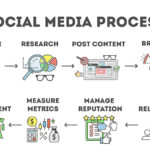Boosting Your Lead Management Efforts
As a small business owner, you know that getting quality leads is vital for the growth and success of your venture. However, not all leads are the same, and a one-size-fits-all approach to lead management may not yield the desired results. That’s where customer segmentation comes to the rescue! By dividing your potential customers into specific groups based on shared characteristics, preferences, and behaviors, you can customize your marketing efforts to meet their needs better and increase lead generation. In this article, we’ll delve deeper into the concept of customer segmentation and provide simple yet effective tips to enhance your lead management and boost conversion rates.
If you want the basics for Customer Segmentaiton check out: Customer Segmentation Made Easy.
I. Understanding Customer Segmentation
Customer segmentation categorizes your target audience into groups or segments based on shared characteristics and behaviors. This helps you better understand your customers and enables you to create more personalized and targeted marketing strategies.
Types of customer segmentation:
- Demographic segmentation: Dividing customers based on demographic factors such as age, gender, income, occupation, and education level.
- Psychographic segmentation: Segmenting customers based on their interests, attitudes, values, lifestyle choices, and personality traits.
- Geographic segmentation: Categorizing customers based on their geographical location, climate, culture, or regional preferences.
- Behavioral segmentation: Classifying customers based on their past behaviors, purchase history, online activities, engagement levels, and response to marketing campaigns.
II. Benefits of Customer Segmentation for Lead Management
Implementing customer segmentation offers numerous advantages that can significantly enhance your lead management efforts:
- Enhanced personalization and targeted marketing: By understanding each customer segment’s specific needs and preferences, you can create personalized marketing messages and experiences that resonate with their unique requirements, resulting in higher engagement and conversion rates.
- Improved lead nurturing and conversion rates: Customer segmentation allows you to tailor your lead nurturing strategies to match the characteristics and behaviors of each segment. This personalized approach builds stronger relationships with potential customers and increases the likelihood of converting leads into paying customers.
- Higher customer satisfaction and loyalty: When you deliver targeted marketing messages and personalized experiences to your customers, they feel understood and valued. This fosters customer satisfaction, strengthens brand loyalty, and encourages repeat business.
- Efficient resource allocation and budget optimization: Customer segmentation helps you allocate your marketing resources and budget more effectively. By focusing your efforts on the most profitable and responsive customer segments, you can optimize your marketing spend and maximize your return on investment.
III. Steps to Implement Advanced Customer Segmentation
To implement customer segmentation successfully, follow these steps:
- Collect and analyze customer data: Gather relevant data about your customers, including demographic, psychographic, geographic, and behavioral information. This can be obtained through surveys, website analytics, social media insights, or customer relationship management (CRM) software.
- Identify common characteristics and patterns: Analyze the collected data to identify similarities and patterns among your customers. Look for shared traits and behaviors that can be used to group them into distinct segments.
- Develop detailed buyer personas: Create detailed profiles of your target customers within each segment. These buyer personas should include demographics, preferences, challenges, goals, and motivations. This helps you understand and empathize with each segment better.
- Tailor marketing messages and channels: Customize your marketing content and communication channels to align with the preferences and characteristics of each segment. This ensures that your messages resonate with your target audience and increases the likelihood of capturing their attention.
- Implement targeted marketing campaigns: Utilize the segmentation data to create personalized marketing campaigns for each segment. Craft tailored offers, promotions, and experiences that address each customer group’s specific needs and pain points.
IV. Tools and Technologies for Customer Segmentation
Several tools and technologies can assist you in implementing and managing customer segmentation effectively:
- Customer relationship management (CRM) software: CRM platforms help you store and organize customer data, track interactions, and manage customer relationships. They often offer segmentation features that allow you to categorize customers based on specific criteria.
- Marketing automation platforms: These platforms enable you to automate marketing tasks, including segment-specific campaigns, email marketing, and lead nurturing workflows. They streamline your segmentation efforts and ensure timely and targeted communication with your customers.
- Analytics tools for data analysis and insights: Utilize analytics tools to gain insights from customer data and track the performance of your marketing campaigns. These tools provide valuable information about customer behavior, preferences, and the effectiveness of your segmentation strategies.
- Social media listening and monitoring tools: Monitor social media platforms to gather real-time information about customer sentiment, preferences, and interactions. This data can help you refine your segmentation approach and identify emerging trends.
V. Monitoring and Measuring the Effectiveness of Customer Segmentation
To ensure the effectiveness of your customer segmentation efforts, monitor and measure the following key performance indicators (KPIs):
- Conversion rate: Track the percentage of leads that convert into paying customers for each customer segment. This helps you assess the effectiveness of your segmentation strategy in driving conversions.
- Customer acquisition cost: Calculate the cost associated with acquiring customers for each segment. This allows you to evaluate the efficiency of your marketing spend and identify segments that offer the best return on investment.
- Customer lifetime value: Measure the value generated by each customer segment over their lifetime as a customer. This metric helps you identify segments with higher profitability and prioritize your marketing efforts accordingly.
- Return on investment (ROI): Evaluate the overall return on your marketing investment for each customer segment. This enables you to allocate resources and budget strategically based on the segments that yield the highest ROI.
Regularly track and evaluate the performance of each segment, and adjust your segmentation strategy based on feedback and results. Continuously refine your approach to ensure that it aligns with the evolving needs and behaviors of your target audience.
Customer segmentation plays a vital role in improving lead management by enabling businesses to identify and engage with their target audience more effectively. By implementing the steps outlined in this blog post and utilizing appropriate tools and technologies, you can optimize your marketing efforts, boost conversion rates, and foster long-term customer relationships. Embrace the power of customer segmentation and take your lead management to new heights!
Segmentation and Content Marketing Synergy
Content marketing can greatly benefit from customer segmentation. Use your insights to create content that appeals to different segments:
- Educational Content for New Leads: For those in the early stages of the sales funnel, educational content can help establish your brand as a thought leader.
- Solution-Oriented Content for Prospects: Prospects who are considering your products will appreciate content that demonstrates how your solutions address their pain points.
- Customer Success Stories for Decision Makers: Sharing success stories and testimonials can sway those on the cusp of making a purchase decision.
- Exclusive Offers for Loyal Customers: Reward loyal customers with exclusive content, offers, or insider information to encourage retention and advocacy.
Ethical Considerations in Customer Segmentation
As you collect and utilize customer data, it’s important to address the ethical considerations:
- Privacy and Consent: Ensure that your data collection methods are transparent and that customers have consented to how their information will be used.
- Data Security: Implement robust security measures to protect customer data from breaches and unauthorized access.
- Bias Avoidance: Be mindful of unintentional biases in your segments that could lead to discriminatory marketing practices.
Actionable Takeaways for Small Business Owners
- Audit Your Current Segmentation Strategy: Review what’s working and identify areas for improvement.
- Invest in Technology: Consider budget-friendly AI and analytics tools tailored for small businesses.
Test and Learn: Run small-scale tests on your segmentation strategies and learn from the results to refine your approach. - Stay Compliant and Ethical: Regularly update your practices to align with evolving data protection regulations and ethical standards.

Since its launch in 2016, Bizbotweb has been at the forefront of empowering businesses and individuals to easily navigate the digital world, from owning their intellectual property to managing websites and simplifying WordPress setups. As the author of our articles, the “Chief Robot” brings a wealth of knowledge and innovation, embodying Bizbotweb’s commitment to making digital presence seamless and accessible for everyone. Focusing on integrated digital marketing efforts, our content is designed to guide users through the evolving digital landscape, ensuring they have the tools and insights needed to thrive online.
Blog Categories
Check out other Pages
Have questions?
Schedule a free consultation if you have questions about our digital marketing services or would like additional information.










